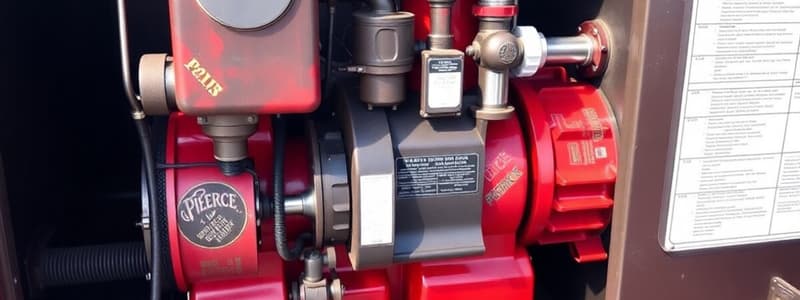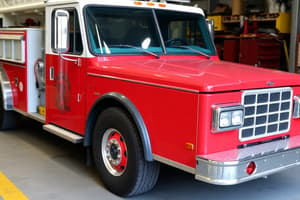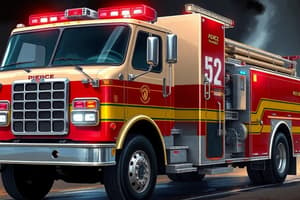Podcast
Questions and Answers
Who is responsible for servicing and maintaining the vehicle?
Who is responsible for servicing and maintaining the vehicle?
- Anyone who operates the vehicle
- Only trained professionals
- Only the manufacturer
- The owner and operator (correct)
What should someone do if they lack knowledge about vehicle maintenance?
What should someone do if they lack knowledge about vehicle maintenance?
- Consult the operation manual or seek assistance (correct)
- Wait for a failure to occur before learning
- Attempt to fix issues independently
- Ignore the maintenance guidelines
Which of the following is important for keeping knowledge about vehicle operation current?
Which of the following is important for keeping knowledge about vehicle operation current?
- Participating in training and professional organizations (correct)
- Reading outdated manuals
- Assuming previous knowledge is sufficient
- Neglecting safety updates
What is the purpose of safety warning labels on the vehicle?
What is the purpose of safety warning labels on the vehicle?
Which of the following is essential for daily checks of the vehicle?
Which of the following is essential for daily checks of the vehicle?
In case of a safety defect, what action should be taken?
In case of a safety defect, what action should be taken?
What precautions should be taken when working near high-pressure water streams?
What precautions should be taken when working near high-pressure water streams?
What is required before removing intake and discharge caps?
What is required before removing intake and discharge caps?
What must be done before engaging a PTO-driven pump for stationary operation?
What must be done before engaging a PTO-driven pump for stationary operation?
What will happen if the parking brake is released during pump operation?
What will happen if the parking brake is released during pump operation?
How should the wheels be secured when the vehicle is parked for pump operation?
How should the wheels be secured when the vehicle is parked for pump operation?
What should be done if hoses are not ready after engaging the pump?
What should be done if hoses are not ready after engaging the pump?
What indicates that the PTO is engaged and the pump is spinning correctly?
What indicates that the PTO is engaged and the pump is spinning correctly?
What should be avoided during pump-and-roll operation?
What should be avoided during pump-and-roll operation?
What could happen if the pump runs dry for more than a few minutes?
What could happen if the pump runs dry for more than a few minutes?
Which step is NOT necessary for engaging the pump in stationary operation?
Which step is NOT necessary for engaging the pump in stationary operation?
What is the primary function of the engine cooler valve when it is open?
What is the primary function of the engine cooler valve when it is open?
How should the engine cooler valve be adjusted during winter?
How should the engine cooler valve be adjusted during winter?
What should be done if the pump-overheat indicator turns ON?
What should be done if the pump-overheat indicator turns ON?
Which statement about the recirculating line is correct?
Which statement about the recirculating line is correct?
What is the purpose of the engine cooler transferring heat to pump discharge water?
What is the purpose of the engine cooler transferring heat to pump discharge water?
What is the first step to open the engine cooler valve?
What is the first step to open the engine cooler valve?
How does the discharge valve typically operate?
How does the discharge valve typically operate?
What action should be taken if the pump is overheating?
What action should be taken if the pump is overheating?
What should you do if engine control is lost at the pump panel?
What should you do if engine control is lost at the pump panel?
What can happen if the pressure rating of downstream devices is exceeded?
What can happen if the pressure rating of downstream devices is exceeded?
Which factor does NOT contribute to determining the desired pump pressure?
Which factor does NOT contribute to determining the desired pump pressure?
When operating without a pressure governor, when can you change engine RPMs according to the interlock lamp?
When operating without a pressure governor, when can you change engine RPMs according to the interlock lamp?
What is a consequence of keeping control of hoses under pressure?
What is a consequence of keeping control of hoses under pressure?
Where should the pump chart be kept for the pump operator?
Where should the pump chart be kept for the pump operator?
Which of the following is affected by discharge restrictions in determining pump pressure?
Which of the following is affected by discharge restrictions in determining pump pressure?
What is the primary use of a pressure governor in a pumping system?
What is the primary use of a pressure governor in a pumping system?
What is the primary risk associated with opening valves rapidly in a water pumping system?
What is the primary risk associated with opening valves rapidly in a water pumping system?
What should be done while the attack line is being filled with water?
What should be done while the attack line is being filled with water?
What action is recommended after air is released from the attack line?
What action is recommended after air is released from the attack line?
What is a critical precaution when operating a pump from a draft water supply?
What is a critical precaution when operating a pump from a draft water supply?
What happens if the pump operates with the discharge valves closed for an extended period?
What happens if the pump operates with the discharge valves closed for an extended period?
Which valve should be closed when disengaging the pump after use?
Which valve should be closed when disengaging the pump after use?
What is a consequence of water hammer in a pumping system?
What is a consequence of water hammer in a pumping system?
What should be closely monitored to manage the water supply effectively?
What should be closely monitored to manage the water supply effectively?
What should be done to avoid tank overflow when the tank-to-pump valve is closed?
What should be done to avoid tank overflow when the tank-to-pump valve is closed?
What is recommended to ensure continued water supply when switching to an external water source without a Gated Intake Valve?
What is recommended to ensure continued water supply when switching to an external water source without a Gated Intake Valve?
What action should be taken to prevent pump overheating during prolonged operation with closed discharge valves?
What action should be taken to prevent pump overheating during prolonged operation with closed discharge valves?
What precaution should be taken before removing the intake cap when switching the water supply?
What precaution should be taken before removing the intake cap when switching the water supply?
What should you do after opening the hydrant valve when connecting an intake hose?
What should you do after opening the hydrant valve when connecting an intake hose?
Why is it important to have an Intake Gate Valve on a pumper apparatus?
Why is it important to have an Intake Gate Valve on a pumper apparatus?
What occurs if the pump is operated with closed discharge valves for an extended period?
What occurs if the pump is operated with closed discharge valves for an extended period?
What is the purpose of the thermal relief valve fitted on the pump?
What is the purpose of the thermal relief valve fitted on the pump?
Flashcards
Owner's responsibility
Owner's responsibility
The owner is responsible for using, servicing, and maintaining the vehicle properly.
Daily checks
Daily checks
Essential procedures a vehicle owner performs daily to manage their fire truck.
Safety warnings
Safety warnings
Important cautions, warnings, and signals related to vehicle operation.
High-pressure water streams
High-pressure water streams
Warnings related to the potential danger of high water pressure emitted from a fire engine hose
Signup and view all the flashcards
Hose testing
Hose testing
Procedures to execute while performing hose assessments for fire suppression efficiency
Signup and view all the flashcards
Professional organizations
Professional organizations
Associations that provide training, standards and support regarding equipment maintenance.
Signup and view all the flashcards
Safety defect reporting
Safety defect reporting
Process for reporting concerns or damage relating to firefighting equipment safety.
Signup and view all the flashcards
Seeking knowledge refreshers
Seeking knowledge refreshers
Staying up-to-date on product and safety information regarding firetruck operation and maintenance.
Signup and view all the flashcards
PTO-driven pump engagement (stationary)
PTO-driven pump engagement (stationary)
Procedure for engaging the PTO-driven pump when the vehicle is stationary.
Signup and view all the flashcards
Pump in Neutral
Pump in Neutral
Label indicator on vehicles with PTO-driven pumps that the transmission must be in neutral.
Signup and view all the flashcards
Parking brake application
Parking brake application
Essential step to apply the parking brake before PTO pump engagement.
Signup and view all the flashcards
Wheel chocking
Wheel chocking
Practice of securing the vehicle's wheels to prevent movement during pump operation.
Signup and view all the flashcards
PTO pump shift control
PTO pump shift control
Control on the driver's panel, used to activate PTO-driven pump engagement.
Signup and view all the flashcards
Pump Engaged Indicator
Pump Engaged Indicator
Indicator light that illuminates when the PTO is engaged and the pump is spinning.
Signup and view all the flashcards
Pump overheating prevention
Pump overheating prevention
Practices to keep pump water cool to prevent overheating, like recirculation and not operating with closed discharge too long.
Signup and view all the flashcards
Pump-and-roll operation
Pump-and-roll operation
Operation where the vehicle moves while the pump is on, which is specifically dangerous.
Signup and view all the flashcards
Recirculating Line
Recirculating Line
The line that prevents water from flowing to the pump, requiring tank to pump valve or water source.
Signup and view all the flashcards
Engine Cooler Valve
Engine Cooler Valve
A valve that allows engine heat to be transferred to pump water, enhancing cooling in hot conditions.
Signup and view all the flashcards
Valve Opening
Valve Opening
Turning knob counter-clockwise opens the valve, enabling operation.
Signup and view all the flashcards
Pump Overheat Indicator
Pump Overheat Indicator
A device that signals pump overheating. Must take action!
Signup and view all the flashcards
Discharge Valve Operation
Discharge Valve Operation
Discharge valves are operated with hand wheels or levers; clockwise to close, counter-clockwise to open. Electronic controls may exist.
Signup and view all the flashcards
Cold Weather Operation
Cold Weather Operation
Engine cooler valve should be closed for better cab heating during cold temperatures.
Signup and view all the flashcards
Hot Weather Operation
Hot Weather Operation
Open engine cooler valve for more engine cooling with increased air temperatures (above 80 degrees F).
Signup and view all the flashcards
Overheating Mitigation
Overheating Mitigation
Address pump overheating symptoms by adding fresh water, recirculating, draining water, or, if needed, turning the engine OFF.
Signup and view all the flashcards
Charging Line Operation
Charging Line Operation
Method for filling and operating attack lines connected to a fire pump.
Signup and view all the flashcards
Pressure Spikes
Pressure Spikes
Unexpected increases in water pressure, potentially damaging hoses and causing injury.
Signup and view all the flashcards
Water Hammer
Water Hammer
Pressure waves caused by rapid valve closure, potentially damaging pump and system components.
Signup and view all the flashcards
Static Water Supply Operation
Static Water Supply Operation
Pumping from a stationary water source, known for the high demands.
Signup and view all the flashcards
Pump Overheating
Pump Overheating
A malfunction caused by sustained operation with closed discharge valves.
Signup and view all the flashcards
Tank Level Indicator
Tank Level Indicator
Device tracking water level in the water tank supplying the pump.
Signup and view all the flashcards
Discharge Valve Adjustment
Discharge Valve Adjustment
Fine-tuning the discharge valve after initial filling to ensure consistent water flow.
Signup and view all the flashcards
Discharge Valves and Drains
Discharge Valves and Drains
Valves controlling water flow from the pump and drains for removing excess water.
Signup and view all the flashcards
Tank Overflow Prevention
Tank Overflow Prevention
Closing the tank-fill or recirculating valves prevents the water tank from overflowing.
Signup and view all the flashcards
Pump Cooling
Pump Cooling
To prevent pump overheating, ensure discharge valves are open when the pump is operated.
Signup and view all the flashcards
Changing Water Source (No Intake Gate Valve)
Changing Water Source (No Intake Gate Valve)
When switching from a water tank to an external source (hydrant), stop water flow to discharge lines.
Signup and view all the flashcards
Closing Discharge Valves
Closing Discharge Valves
Before changing water sources, close the discharge valves to safeguard personnel from sudden water pressure changes.
Signup and view all the flashcards
Pump to Idle Speed
Pump to Idle Speed
Reduce pump speed to IDLE to prevent damage to pump seals and bearings when water supply is stopped.
Signup and view all the flashcards
Closing Tank-to-Pump Valve
Closing Tank-to-Pump Valve
Prevent water from escaping the tank's inlet before connecting an intake hose by shutting off the valve before opening the intake cap.
Signup and view all the flashcards
Hydrant Flush
Hydrant Flush
Open hydrant valve and vent hose for 30 seconds to flush out debris before connecting it to the pump.
Signup and view all the flashcards
Charging Intake Hose
Charging Intake Hose
To start pumping water properly, open the tank fill or discharge valve to expel air from the intake hose.
Signup and view all the flashcards
Pump Pressure Control
Pump Pressure Control
Regulating engine speed to control pump pressure. This is done by adjusting engine speed or using a pressure governor.
Signup and view all the flashcards
Discharge Pressure Limits
Discharge Pressure Limits
Never exceed the pressure rating of hoses and nozzles to prevent explosions.
Signup and view all the flashcards
Pump Pressure Factors
Pump Pressure Factors
Pump pressure depends on engine speed, pump size, and discharge/intake/system restrictions.
Signup and view all the flashcards
Pump Chart
Pump Chart
A chart recording pump pressure for various fire fighting situations (based on nozzle pressure and attack lines).
Signup and view all the flashcards
Pump Pressure (No Governor)
Pump Pressure (No Governor)
Pump pressure control without an automatic pressure governor requires manual engine speed adjustments.
Signup and view all the flashcards
Interlock Lamp
Interlock Lamp
A light that indicates when engine RPMs can be changed on the pump panel.
Signup and view all the flashcards
Interlock Lamp Conditions
Interlock Lamp Conditions
Two conditions activate the interlock lamp: Parking brake applied and transmission in 4th gear lockup OR Pump Shift Complete.
Signup and view all the flashcards
Hand Throttle System Malfunction
Hand Throttle System Malfunction
If the hand throttle fails during pumping, use the foot pedal in the cab to maintain operation.
Signup and view all the flashcardsStudy Notes
Operation & Maintenance Manual - Pierce Pumper
- Manual Overview: Covers operation and maintenance of a Pierce Pumper, including safety procedures, daily checks, custom products, cautions, warnings, and dangers. Includes chapters on before placing in service, operation, and maintenance.
Chapter 1: To the Owner
-
Responsibility: Operators are responsible for understanding components, controls, and operation procedures. They must also know emergency procedures in case of a component failure.
-
Daily Checks: Follow departmental apparatus checks and verify all controls (valves, switches, etc.) are operational. Pay extra attention to seldom used controls.
-
Custom Products: Pierce apparatus specifications may vary, so detailed knowledge of the specific apparatus is crucial.
-
Safety Warning Labels: Danger, Warning, and Caution labels are used to identify hazards and indicate potential consequences - death or serious injury, death or serious injury, or minor to moderate injury, respectively.
Chapter 2: Before Placing In Service
-
Pump Chart: Creation of a pump chart for the apparatus.
-
Intake Relief Valve: Checking and adjusting the intake relief valve.
Chapter 3: Operation
-
Approaching the Apparatus: Safety precautions for entering and exiting the vehicle, including stepping, walking surfaces, and compartment doors. Avoid climbing or walking on potentially unsafe areas.
-
Hose: Storage, restraint, and deployment procedures. Securely restrain hoses while in motion to prevent entanglement and injury.
-
Pump Engagement and Disengagement: Procedures for engaging and disengaging the driveline-driven pump, including manual override options (optional), for PTO-driven pumps (stationary/driving).
-
Supply and Discharge Water and Foam: Procedures for supplying water to the pump, and discharging water or foam.
-
Changing Water Supply (Tank to External): Procedures for transferring water from the tank to another external supply (e.g., hydrant).
-
Pump Pressure Control and Systems Monitoring: Procedures for controlling engine speed according to pump pressure requirements.
Chapter 4: Maintenance
-
General Maintenance: Annual testing, cleaning, and maintenance schedules for the apparatus.
-
Pump Maintenance: Procedures for draining, flushing parts of the apparatus, and other pump-related maintenance.
Additional Information
-
Engine Status Display: Critical performance details like engine speed, oil pressure, oil temperature, electrical system voltage can be monitored by observing the status display.
-
Ending Water Flow Operation: Describes procedures for shutting off water flow, disengaging the pump and securing the pumping system.
Studying That Suits You
Use AI to generate personalized quizzes and flashcards to suit your learning preferences.




